Despite playing some relatively hardcore games, my partner had seemingly always been opposed to the concept of gaming on a computer. On one hand, I understand wanting to keep some kind of separation between work, school, and innumerable other “serious” activities you might use a computer for, and pure entertainment, like gaming. On the other hand, several of her favorite genres, city building and adjacent strategy games, for example, are quite PC-centric. It has also been a struggle to find good opportunities for “couch” cooperative play, regardless of genre, on consoles over the years, yet there is what seems like a constant drip of intriguing online co-op games being released on PC. At some point in the last year she had a total change of heart and decided she wanted me to build her a gaming PC for her birthday. Once completed, we almost immediately dove into the deep end with one of her other favorite genres, open world sandbox survival.
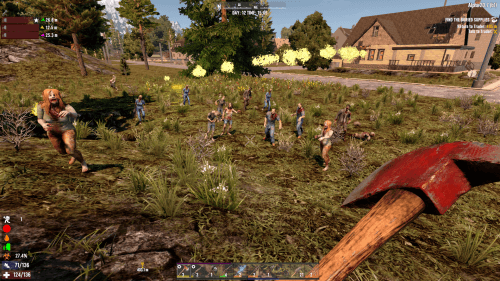
“Zombie horde, meet Iron Fireaxe!”
I’ve talked about 7 Days to Die a little bit on here before, as we’d played the Xbox One version of it split-screen years ago, but the console ports lagged behind the development of the PC version and were eventually entirely abandoned. Once we had our fill of that version, we left and never went back, though often lamented not being able to play the supposedly superior PC version. Playing it on PC promised a lot more content, better graphics and performance, and, as luck would have it, the ability for us to jump in with family who were already fans of the game for a much more lively 4 player romp. Did it deliver? Well, yes!
While I still can’t escape the slightly janky look and feel of 7 Days to Die, it’s undeniably a vastly superior experience all around on PC. One of our team was quite seasoned at the game, so with his guidance, we immediately found ourselves a home base and began gathering equipment and leveling up our characters via the game’s traders and their dynamic quests. We played at least two whole campaigns, and though the game doesn’t really have a true ending, we progressed through all of the quest, gear, and skill tiers in both. In fact, we spent so much time in the game that I think I’ve had my fill for a while. While there’s always fun to be had with the emergent quality of playing these types of open world games, especially with other people, survival games like this tend to be the most fun while first figuring them out, and maybe an additional time after you have a better understanding of the systems at play. After that, the best reason to jump back in is a big new patch that overhauls systems and adds new content, which thankfully 7 Days to Die does yearly or thereabouts. On top of the basic gameplay loop and systems therein becoming a known quantity, I found 7 Days to Die’s character and tech progression to be just a bit boring.
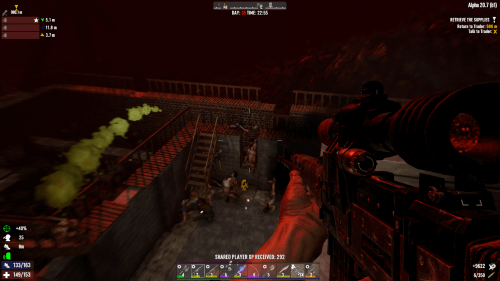
“Sniping zombies as they funnel into our compound during a Blood Moon.”
Moment to moment gameplay isn’t particularly exciting either, and although there’s always a bit of tension when exploring a new building to clear out a zombie infestation in order to complete a quest, for instance, it doesn’t quite pull off the same feel of desperate scavenging that made me love State of Decay so much. Where it does succeed magnificently is the “Blood Moon” horde night mechanic which the game is named after. That is, every 7th night a massive horde of zombies spawns, relentlessly focusing on the players. At first this usually plays out like the end of the grandfather of the entire zombie genre, Night of the Living Dead, wherein a ragtag group of survivors has to hole up in a loosely reinforced building and fend off a seemingly unending number of increasingly violent attacks with little to no resources, counting the minutes until the relative safety of sunrise. Later, you’ll have hopefully found (or built) a compound more capable of surviving such attacks, with multiple walls, trenches, tripwires and other traps, automatic turrets, sniper towers, and maybe even a safe room or emergency evacuation route if things totally go off the rails. In either case, thanks to the game dynamically adjusting the difficulty of these events as you progress, the stress of these chaotic nights is real, and the loop of preparing for, participating in, and recovering from them makes up for just about all of the game’s other shortcomings
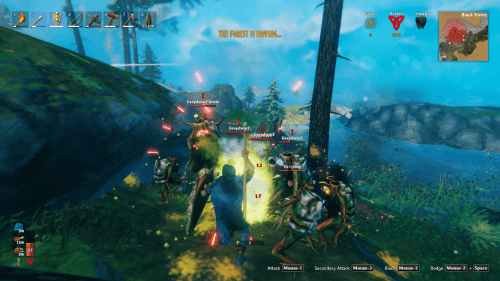
“The locals sometimes get a little feisty.”
At around the same time that we were playing 7 Days to Die the most, I’d also hopped into a Valheim server some of my coworkers setup after the release of the Mistlands patch. While I had briefly checked out Valheim solo a few months prior, for all intents and purposes, this was my first time playing the game. It was fun to play these two games so close together, since they’re quite similar, but diverge in some very interesting ways, with Valheim coming across as having much more carefully designed, less punitive systems, seemingly in response to earlier titles in the genre. Most notably, Valheim is less focused on “surviving” which means the fiddly bits (and therefore much of the hassle) of things like eating and drinking, repairing your gear, watering crops, feeding animals, upkeep on buildings, etc. are mostly eliminated. That’s not to say they’re not there at all; the comfort awarded by a good warm, dry structure and a full belly come in the form of increasingly large buffs, and these buffs are as essential as upgraded gear as you get further into the game.
As for gear, progression largely comes in the form of the typical material to tool to material loop, which is somewhat gated by individual biomes. That is, while you’re technically able to explore the entire map from the get go, and exploring is definitely compelling, each biome also has a “boss” which rewards you with items and abilities that will often be required for getting certain resources from the next biome. It’s a simple but clever progression mechanic. Likewise, enemies in each new biome serve as something of a soft gate as well. Heading into an area more than one above where you’ve progressed is likely a death sentence until you have better gear and better buffs. While it feels more natural than level-based “zones” of theme park style MMORPGs, it has a similar effect.
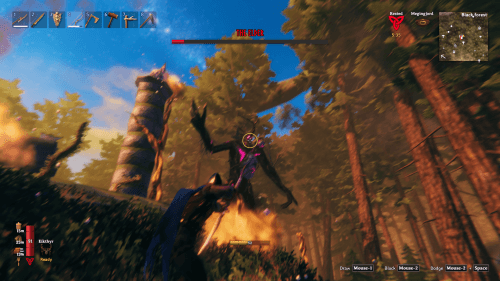
“Finishing off The Elder, the Black Forest’s boss.”
Construction, along with the systems and physics around it, is quite nice too. Like 7 Days to Die, Valheim has a voxel-esque engine which allows for fairly robust terrain deformation and reasonably free-form building (like Minecraft, to use my usual reference) and while It does have less realistic, far simpler graphics, it makes up for that by the use of a combination of a nice art style and quite few effects, resulting in a unique, cool aesthetic. Your home base will grow, especially in multiplayer games, into full on compounds, and these will need some defenses due to the denizens of whatever biome you’re in, and more importantly, enemy raid events which tier up along with your biome progression. These tend to be more of a minor annoyance than the session defining white-knuckle Blood Moons of 7 Days to Die, but I appreciate that they at least give me another reason to build new things and improve old ones.
On the other hand, building and crafting is where the game can get a little grindy. The more ambitious you are, the more material you need. Upgrading our little town from mostly wood to mostly stone wasn’t so bad, but when we decided to add stone basements to all of our buildings and connect them with a tunnel system, and then later build a massive wall and moat around the entire thing, we were suddenly spending a lot of time mining and hauling stone. The move to higher tier metals and other materials was even worse, with hours on end spent mining ore and rows of smelters cranking out ingots like some kind of Victorian factory.
It’s around that time that I fell off of Valheim. We made it as far as the mountain biome, and while there was definitely more to see, by then I felt like I had gotten to know what to expect from the gameplay loop. There’s a lot more I could talk about, like sailing, the cool fire propagation system, portals, the boss battles themselves, and the mini dungeon crawls, but in summary, Valheim was absolutely excellent, and I’d guess I’ll return to it as more content continues to be released for it.
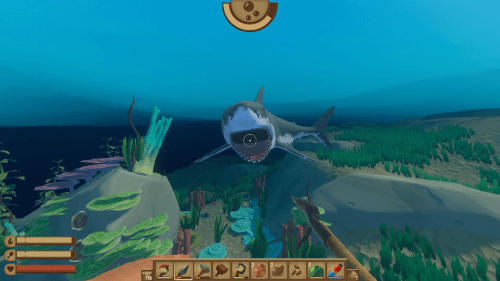
“Meet Bruce. You’ll probably spend more time with him than your co-op partners…”
While playing 7 Days to Die, I wanted to start a game with my partner that we could play on our own time, separate from organizational constraints of playing with a larger group. I also wanted to play something a little more “chill” than 7 Days. We ended up settling on 2022’s Raft.
Raft is, well, it’s kind of all in the title. The basic premise is that you start on a tiny raft floating in a more or less endless ocean. You need to gather material from debris floating around you, on islands you’ll randomly encounter, and in the reefs around them, to expand and improve your raft, take care of your hunger and thirst, and of course, improve your gear. I almost immediately found the simplicity of most of the mechanics around gathering and crafting, as well as the amount of interesting tools and purely cosmetic items (furniture, etc.) to be quite fun, giving the game a really solid foundation that thankfully lasted throughout our entire playtime. Additionally, Raft has some great aesthetics. Likely thanks in large part to now classics like World of Warcraft and Team Fortress 2, it seems like slightly cartoony, minimalist art styles are quite prevalent with sub AAA games these days, and ever since falling in love with Firewatch, I’ve been a big fan of this kind of look when it’s done competently.
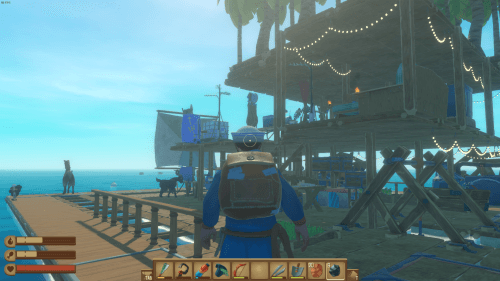
“Home sweet home, near endgame.”
That all said, this game definitely isn’t quite as chill as I’d originally expected. From the get-go, you’re nearly constantly harassed by a huge great white shark who seems to have a personal vendetta against you. While you’ll need to stop it from taking chunks out of your raft fairly regularly, it’s at its most annoying when you’re diving for resources. There are also other aggressive animals, such as bears, on some of the islands, and both they and the shark seem to have fairly aggressive respawn timers to boot. Combat is really simple, and while it won’t blow anyone away, I didn’t find that it detracted much from the game either. Survival has even less chill, as with little in the way of tutorialization to go on, we found ourselves having to restart our first several games due to running out of food, losing our raft entirely, and one time being stranded in an area with next to no wind to sail by and broken oars – we’d run out of material to build new ones, and there wasn’t any floating debris in sight. Even once we had a pretty good grasp on what we were doing, it took us forever to discover the blueprints for the receiver and antenna, upon which your progress for the rest of the game depends. That was probably just a bit of bad luck with “RNJesus”, though.
One thing that had initially really intrigued me about Raft was that, unlike the almost completely absent stories of 7 Days to Die and Valheim, it supposedly had an actual narrative. Unfortunately, I found that aspect of the game a little disappointing. There are “story islands” that you progress through linearly which are special handcrafted locations featuring puzzles, backstory in the form of audio and text logs, and sometimes special items and even boss fights. There is also a way to guide yourself from story island to story island (the aforementioned receiver and antennas) which hopefully means you’ll never get too far off the beaten path. While there’s definitely a bit of mystery there, like why the planet flooded or, hell, why our characters are floating around on a tiny raft with no supplies at the start of the game, I don’t feel like Raft capitalizes on it anywhere close to well enough. The whole thing, particularly the end, felt a little rushed. Was I the only one who found the repeated references to “Forward Scouts” on the last story island when I think that term had only been used once or twice prior in the entire rest of the game to be a bit jarring? Besides, how am I a “scout” when I don’t seem to have relayed any of the information I’ve gathered back to anyone, and who am I scouting for, exactly? It’s not distracting while playing, but upon further reflection, it just all feels just a little half-baked.
That all said, we did eventually beat Raft, and I think in the end, we both really enjoyed the experience.
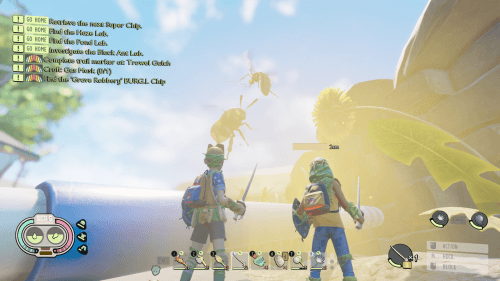
“Stand aside insects, we have a huge quest list to complete.”
Once our 7 Days to Die crew reluctantly decided to move on, I urged them to check out Grounded. Grounded follows a lot of the same open world sandbox survival tropes as the other games in this list, but two things immediately made it stand out to me.
First, the theme. Grounded is essentially Honey, I Shrunk the Kids. Set in the early 90s, you play as one of 4 teens shrunken down to the size of a bug, lost in a backyard. It’s a pretty damn cool concept for a game, especially to an old man like me who played countless “giant” deathmatch maps in Unreal Tournament. I’m sure it won’t appeal to everyone, but hopping across clover leaves, sawing down blades of grass like they’re towering trees, and battling huge stink bugs, it’s quite compelling to me, and it’s executed extremely well to boot. Unlike large parts of all three of the above games, the world in Grounded is completely handcrafted rather than procedurally generated, which means, while maybe it is a little less replayable, it’s full of interesting touches.
That’s actually the second thing. Grounded is developed by a studio that a lot of people reading this will be very familiar with, Obsidian Entertainment. I don’t mean to be disrespectful in any way to the developers of these other games, but Obsidian is in a different league, and thanks to their acquisition by Microsoft, one with a bigger budget too. Obviously this isn’t an automatic selling point for everyone, as Obsidian is mostly known for their CRPGs. That, and for putting out… ummm, quite often less than finished games. That said, while I’ve not played many of their more recent titles, Grounded is by far the most polished Obsidian game I’ve ever played. It looks fantastic, sporting a minimalist art style not unlike the sort I mentioned admiring in Raft. It also sounds great, the UI feels well designed, and the whole thing is responsive and smooth. Thanks to its Microsoft association, it’s also on Gamepass and supports crossplay with consoles to boot!
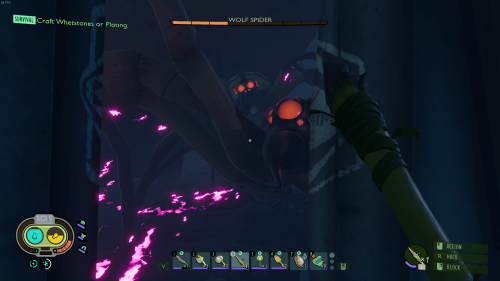
“Cornered by two massive, deadly spiders. Ugh!”
Like Raft, it also has a narrative. Thankfully, I think it succeeds a lot better than Raft on that front, taking an approach similar to many single player open world games, with cutscenes, info dumps, and new missions punctuating the completion of old ones. It has the obligatory text and audio logs too. Of course, like a lot of other open world games, you can tackle many missions in whatever order you want, but my crew quickly discovered that, as an example, you should maybe clear each of the science labs in order rather than attempting to clear out the last one first just because you happen to be near it. Speaking of having less than expected levels of chill (another trait it shares with Raft) I suspect the difficulty of Grounded is one of the main reasons the game isn’t more popular. Despite its cartoony graphics and kid-focused plot, this game is brutal as fuck! It wasn’t uncommon for some of us to get two-shotted by hostile insects early on in the game, and I had a particularly harrowing round of cascading drowning deaths as each subsequent attempt to recover my backpack from a long, dark, underwater tunnel failed spectacularly. Oh, and absolutely turn on that “arachnophobia safe mode” if you’re not down with spiders because, frankly, fuck those things! We narrowly avoided some rage quits and eventually learned a few tricks that really helped us out, and after that, quickly made progress.
Beyond the typical open world survival game gathering and crafting loop, there’s something of a currency called “raw science”. RS is awarded for completing missions, discovering and analyzing new materials, killing certain larger enemies, and can even just found placed throughout the yard. RS can then be used to purchase sets of new crafting plans, recipes, and even mutations. Mutations are a form of character customization perk mostly found when completing certain milestones in the world, which you can then apply a couple of to grant your character special abilities and buffs. There’s also “milk molars” – big teeth you can find in the world and harvest, rewarding you with points you can use to upgrade your stats, including the ability to raise your active mutation count as high as 5. After we hit that aforementioned rough spot when trying to clear the labs, we spent a whole multi hour session farming molars in the world to give ourselves a bit of an edge.
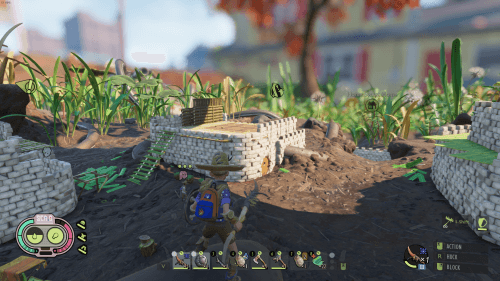
“Surveying our WIP preparation for the final battle.”
As we progressed, the missions eventually focused into a more linear path, culminating in a huge final battle which was sort of a more hardcore version of the much smaller MIX.R wave defense side challenges scattered around the map. I suppose we never took those MIX.R challenges all too seriously, and we failed the final battle in an utterly humiliating fashion the first time around, despite thinking we had a winning strategy. This caused us to over prepare for the next attempt, spending quite a while grinding out more advanced (and stronger) material so that we could build multiple layers of fortifications, ultimately leading to a glorious victory the second time around. It was actually quite fun, looking back, though we were surprised to find the end cutscene representing something of a “bad” ending. It turns out, the bad ending is the normal one, and the better ending is only available to players who defeat some not-at-all signposted side objectives before the final fight. A slightly disappointing end to an otherwise excellent game.
That’s it for now. Next on the list: Enshrouded!